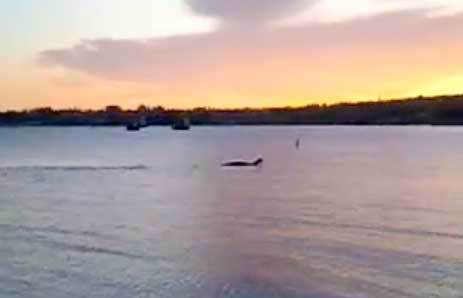Champ: America's Loch Ness Monster
There are many lakes around the world reputed to hold monsters. The cold, deep waters of Loch Ness in Scotland are home to the world-famous Nessie. Canada is said to be home to several lake monsters (including Ogopogo in British Columbia's Lake Okanagan, and Cressie in Newfoundland's Crescent Lake). The American counterpart to Nessie and Cressie is said to lurk in Lake Champlain, on the border between Vermont and New York.
"Champ," as the creature is affectionately called, has allegedly been seen by hundreds of witnesses over the years. Descriptions of Champ vary, but most suggest a creature between 20 and 80 feet long, with a series of distinct humps and a serpentine body. Some say the head looks like a snake or a dog.
The lake (and therefore the monster) is named for French explorer Samuel de Champlain, who is often — but erroneously — said to have been the first to see the creature. Sought after by famous showman P.T. Barnum, featured on the "Unsolved Mysteries" television program, and quasi-officially protected by both the New York State Assembly and the Vermont Legislature, Champ remains a modern mystery.
The 'best evidence' for Champ
The best photographic evidence for Champ — indeed, of any lake monster — is a single snapshot taken in 1977. A woman named Sandra Mansi photographed something dark in the lake one summer day that seemed to form a mysterious dark head and hump. Mansi estimated that the creature's "neck" stuck about six feet out of the water and the whole object was about 12 feet long. The object floated, motionless, for between four and seven minutes before sinking slowly straight down. She also reported that the object's surface looked like tree bark.
Field investigations conducted (by the author of this article) for a Discovery Channel documentary show revealed that Mansi overestimated the object's size; the "neck" of the object sticks about three feet out of the water, and both segments together are about seven feet across.
That dark, humped "creature" was revealed to be a submerged tree trunk briefly brought to the surface by buoyant gases created during decomposition. This is a well-known hydrological phenomenon that has created false lake monster sightings before (the process is similar to why plastic drinking straws rise in carbonated drinks). The only thing that made the Mansi photo unique, mysterious and famous was that it resembled a dinosaur-like head and hump from one angle.
Get the world’s most fascinating discoveries delivered straight to your inbox.
Champ eyewitnesses
With the best evidence for Champ debunked — and no hard evidence such as bones or dead bodies ever recovered — this leaves eyewitnesses to provide the bulk of the proof for the aquatic creature's existence. If the lake monster has been around for hundreds or thousands of years, surely there would be records of it. Indeed, some people believe that early Americans have reported seeing Champ (or its ancestors). In his book "The Untold Story of Champ: A Social History of America's Loch Ness Monster," sociologist Robert Bartholomew notes that "Native Americans living along Lake Champlain told stories of a mysterious 'horned serpent' that was said to reside in the lake. In the early seventeenth century, Abenaki [Indian] guides told French captains to be careful not to disturb the monsters that live in the waters of Lake Champlain."
Though this sort of historical account is offered as evidence for Champ, Bartholomew cautions that it's important to not take these claims at face value: "The natives may have misidentified large fish such as the sturgeon and gar" — both of them large, snakelike fish that exist in Lake Champlain and might be described as a horned serpent. Many native stories and legends described water spirits in lakes and rivers, but they were spiritual entities with supernatural powers, not large unknown animals literally swimming in lakes. [Countdown: Our 10 Favorite Monsters]
Though Champ reports have dropped dramatically since their heyday in the 1980s, they have not entirely vanished. Every few years, an eyewitness or video surfaces of something in the lake. In late May 2009, new footage of Champ was released on YouTube, a two-minute cell phone video showing the silhouette of some object — probably an animal — trying to keep its head above water and swimming toward the shore. The video created a buzz among monster enthusiasts, some proclaiming it was the best evidence for the creature in decades. Unfortunately — and suspiciously to many people — the video stops just seconds before the animal nears the shore so that what climbed ashore could be revealed. There are other clues as to the animal's identity, including that the form resembles a swimming deer or elk, and that it was strange that Champ — an aquatic animal after all — would make such an obvious effort to keep its head above water as seen in the video.
In 2005, a fisherman named Peter Bodette recorded a very short video of what appears to be a large fish under the surface of the water. The video, however, is inconclusive; what some people see as a glimpse of Champ others see as merely an otter or large fish.
Whether or not a monster exists in the lake, it has been embraced by several towns along the lake such as Port Henry, New York, which has a large billboard in town listing famous sightings, and has held parades in honor of Champ. Even the Minor League Baseball team is called The Vermont Lake Monsters. As at Loch Ness, there's a cottage industry with a financial incentive to keep the story alive — and just enough random, ambiguous sightings and photographs to keep the legend alive.
Benjamin Radford is deputy editor of Skeptical Inquirer science magazine and author of six books, including Tracking the Chupacabra and Lake Monster Mysteries: Investigating the World's Most Elusive Creatures. His website is www.BenjaminRadford.com.
Related:



